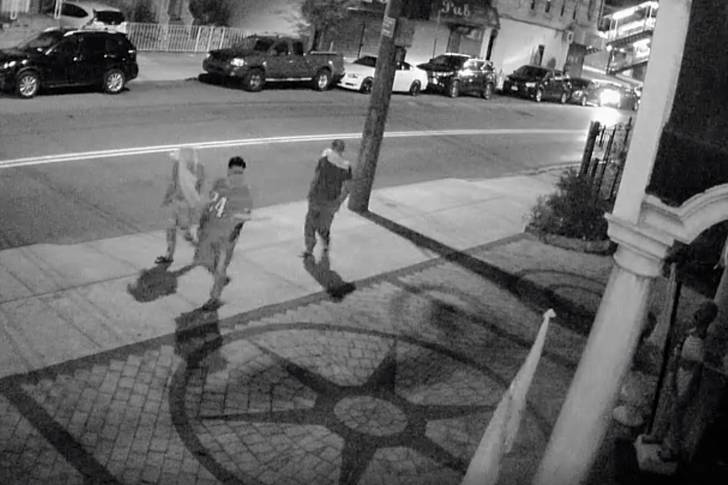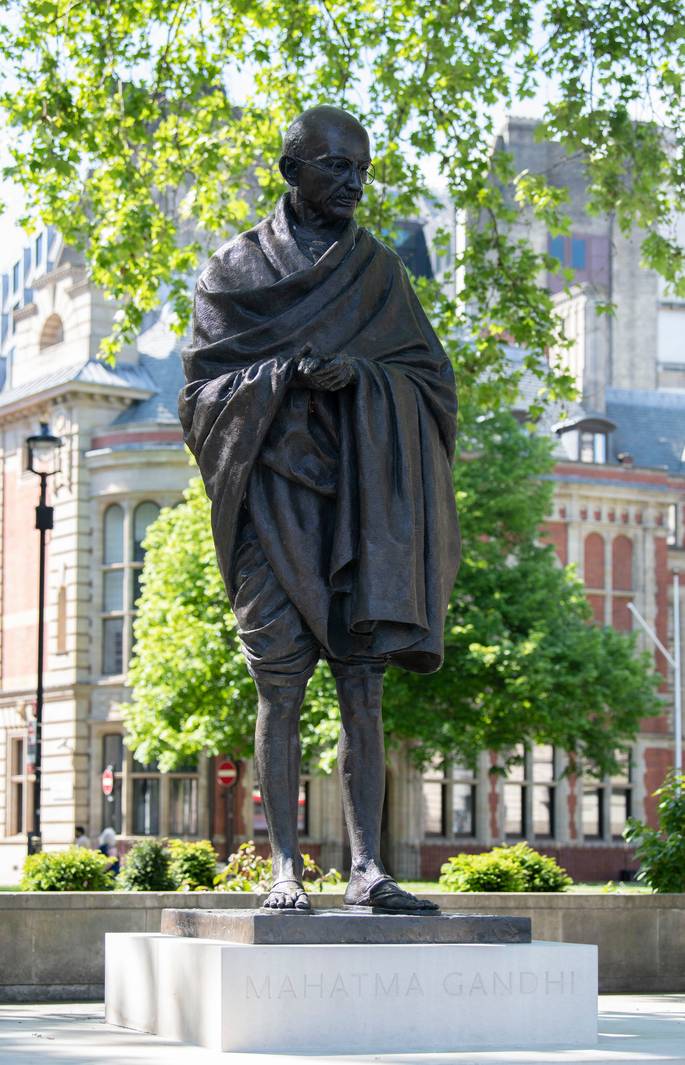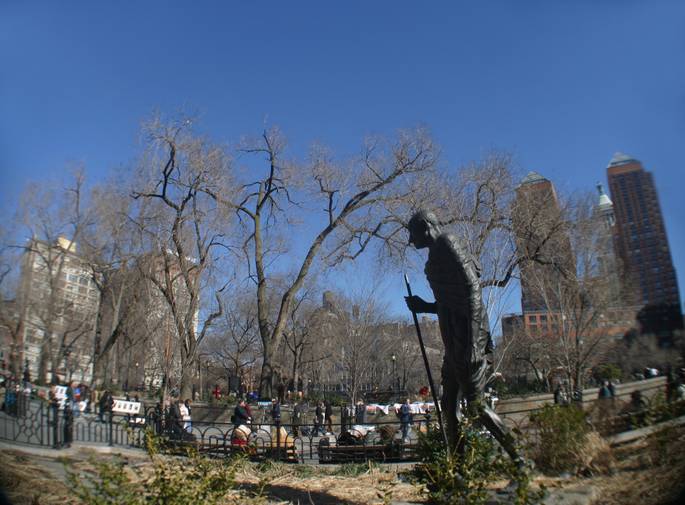
Make your contribution now and help Gothamist thrive in 2022. Donate today
Late one night in August, a Mahatma Gandhi statue outside a Hindu temple in Richmond Hill, Queens, was destroyed by assailants, who toppled the statue before smashing it with a sledgehammer and spray-painting it. Video of the incident caught the license plate of a car allegedly linked to the crime, resulting in an arrest and subsequent hate crime charge against Sukhpal Singh. The 27-year-old from Douglaston, Queens, now faces up to 25 years in prison and is expected to enter a plea at his next court appointment on Dec. 15.
The Aug. 16 incident followed another attack on the same statue two weeks earlier. These were just the latest in a string of incidents where monuments of Gandhi — the late Indian leader and apostle of nonviolence — were vandalized or even decapitated in recent years. These include episodes in Union Square in Manhattan, California, Washington, and outside of Toronto. But teasing out the motivation for the crimes isn’t always so simple. When it comes to Gandhi, the acts are more often tied to political grievances, rather than religious or ethnic bias, South Asian community leaders say.
The distinction is important. Under New York’s hate crime law, as with most state and federal hate crime statutes, a criminal act tied to a perception or belief regarding race, color, national origin or religion – as opposed to political grievance – can result in enhanced penalties adding years to a defendant’s sentence. The politics of Gandhi are complex, leading several South Asian and Hindu leaders to question whether the Queens incident rises to the level of a hate crime.
As folks are immigrating and growing their communities in places like New York, in places like Toronto and places like London, we’re definitely going to see incidents that are connected to homeland politics in these places.
For some observers, the Richmond Hill case is made more challenging by the alleged assailant identifying himself to police as South Asian American, according to court papers. Jagpreet Singh, the political director of DRUM, or Desis Rising Up and Moving, a group that serves poor and working-class South Asians in Queens, said what happens on the subcontinent increasingly filters into what happens in the diaspora. There have been other recent incidents of note, some connected to mass protests against contentious agrarian laws passed by Indian Prime Minister Narendra Modi, and others tied directly to the statements and stances of Gandhi himself.
“As folks are immigrating and growing their communities in places like New York, in places like Toronto and places like London, we’re definitely going to see incidents that are connected to homeland politics in these places,” Jagpreet Singh said.
In addition to the anti-Gandhi incidents, he pointed to an incident in which a bulldozer appeared in an India Day parade in Edison, New Jersey, an overt reference to the bulldozing of Muslim homes in India, as well as the projection of a highly disputed Indian temple on a digital billboard in Times Square. The politics attached to the incidents were not lost on many in the local South Asian community.

The statue of Mahatma Gandhi in Parliament Square, Westminster, London.
“I think it was more anti-Gandhi, not so much as anti-Hindu,” said Dr. Uma Mysorekar, president of the Hindu Temple Society of North America, of the Richmond Hill attack. The society operates the Ganesh Temple, which is located several miles from the site of the destroyed statue and is among the oldest Hindu temples in the U.S.
Mysorekar disagreed with the hate crime charge issued by the Queens district attorney’s office, saying she was yet to see evidence that the statue, outside the Shri Tulsi Mandir in Richmond Hill, was attacked due to anti-Hindu bias.

A Mahatma Gandhi statue in Union Square, Manhattan.
In such cases, said one legal expert, evidence could include prejudiced statements against entire ethnic or religious groups made by a defendant. The office of Queens District Attorney Melinda Katz declined to comment, but in a Sept. 19 statement to the press Katz said the charges were warranted.
“As alleged, the defendant, along with several unapprehended others, committed a disgraceful act of violence against a Mahatma Gandhi statue that has become a universal symbol of peace, unity and inclusivity,” said in the statement. “Hate and bias-motivated attacks have no place in our communities and my office will hold such perpetrators accountable.”
Mysorekar said the attack was unsettling, even if she questions the specific charges.
“The fact that it happened within the temple premises, it always creates a sense of fear, instability, and you don’t know what to expect the next day,” said Mysorekar. “And especially given the circumstances of violence all over the place, it is difficult to swallow this.”
As alleged, the defendant, along with several unapprehended others, committed a disgraceful act of violence against a Mahatma Gandhi statue that has become a universal symbol of peace, unity and inclusivity. Hate and bias-motivated attacks have no place in our communities and my office will hold such perpetrators accountable.
Other Hindus expressed similar sentiments.
Aminta Kilawan-Narine, an attorney and co-founder of Sadhana, the Coalition of Progressive Hindus, said she was “infuriated” when she heard about the attack.
“Because it wasn’t just the Gandhi statue that was vandalized. It was also the pot of a tulsi plant that was broken,” said Kilawan-Narine, referring to holy basil, which is central to Hindu rituals.
Kilawan-Narine said the temple, which serves Hindus in the Indo-Caribbean community, serves as one of the main hosts of an annual Gandhi Peace March in Richmond Hill, and that the institution as a whole “reveres Gandhi and his ideals.” It had also served as a partner for many of Sadhana’s activities, including citizenship drives and legal clinics. Kilawan-Narine’s affection for Gandhi stemmed in part from her need as a child to stay connected to her Indian heritage. As she grew older, however, her views of Gandhi evolved.
‘We drank Jameson’
According to the criminal complaint filed by the Queens district attorney’s office, the defendant Singh told Detective Max Rolffot of the NYPD’s Hate Crime Task Force that “the mainland Indian Punjabs (sic) think that Gandhi is a traitor and betrayed the Indians to the British Empire. I am Punjabi.”
Singh is currently free and has another court appearance in December. Calls to his attorney were not returned. According to the complaint, Singh acknowledged meeting with six to eight friends on the night of Aug. 16, and having drinks.
“We drank Jameson,” he said, according to the statement he allegedly gave police. “We wanted to go out and cause some trouble. One guy had a sledgehammer and another had a spray paint can from work.”
The group, he said, then “went to go get marijuana” before heading to the temple and breaking the statue.
The fact that it happened within the temple premises, it always creates a sense of fear, instability, and you don’t know what to expect the next day. And especially given the circumstances of violence all over the place, it is difficult to swallow this.
In addition to the physical destruction, the words “Gandhi” and “kutta” (Hindi for “dog”) were spray painted on the street.
After the incident, state Assemblymember Jenifer Rajkumar gathered with other elected officials and called for the incident to be investigated as a hate crime.
“The desecration of Gandhi statues and anti-Hindu hate crimes will not be tolerated in Richmond Hill or anywhere in New York state,” said Rajkumar, whose office did not respond to requests for comment.
Council Speaker Adrienne Adams also backed the effort.
Frank Pezzella, an associate professor at the John Jay College of Criminal Justice, said hate crime statutes are meant to address specific crimes – “message crimes” as he calls them – that communicate to an entire group “that you may or may not be safe.”
“When people go around to the temple and they see that Gandhi statue smashed, it sends a message to everybody there,” he said.
However, for prosecutors to obtain a conviction on the hate crime charge, Pezzella said they’ll need to prove that Singh engaged in violence that was “anti-ethnic or anti-religious,” rather than political violence.
“Proving a hate crime charge is extraordinarily difficult,” he said. “You have to get into the mindset of the individual.”
When people go around to the temple and they see that Gandhi statue smashed, it sends a message to everybody there.
Mixed views on Gandhi
In 2020, the latest year for which data is publicly available, there were two acts of anti-Hindu hate reported to police departments and sheriffs across New York state, as well as eight anti-Muslim incidents and 182 anti-Jewish incidents. In the same year, the FBI counted 12 acts of anti-Hindu hate across the country, 94 anti-Sikh hate crimes, 141 anti-Muslim incidents and 959 hate crimes against members of the Jewish community.
Hindu Americans expressed alarm over a recent viral video in which a Hindu man in California was subjected to a long, anti-Hindu tirade by another customer at a Taco Bell who called him a “dirty Hindu.” The accused harasser, a South Asian American identified as Tejinder Singh, was charged with a hate crime. And in 2019, a Hindu priest in New Jersey said he was violently assaulted by a white man who called him a “dirty Indian.”
But a number of observers said that while the incident in Queens was clearly a crime, it wasn’t necessarily a crime born of religious hatred.
“The breaking of the Gandhi statue was an act of vandalism, perhaps driven by a political view of Gandhi,” said Raju Rajagopal of Hindus for Human Rights, “but does not seem to fit the definition of a hate crime against any community or a living person.”
While his influence on civil rights leaders like Dr. Martin Luther King Jr. and South African leader Nelson Mandela are well-documented and raised in the typical public school curriculum, less attention is paid to Gandhi’s many anti-Black statements or his use of a racial slur, as when he objected to “the mixing of the Kaffirs with the Indians.”
Some historians have argued that Gandhi shed his racist views as he aged. Nonetheless, his history of racism has been cited in the removal of a Gandhi statue from the University of Ghana, as well as objections from people in Malawi, who mounted a “Gandhi Must Fall” campaign. In 2020, Black Lives Matter protesters in London wrote “Racist” on a Gandhi statue, and vandalized another in Washington.
Sikhs have their own issues with Gandhi, said Harinder Singh, a senior fellow at the Sikh Research Institute – as do other minority groups in India.
The breaking of the Gandhi statue was an act of vandalism, perhaps driven by a political view of Gandhi, but does not seem to fit the definition of a hate crime against any community or a living person.
He pointed to an episode in the 1930s involving Gandhi and Dr. B.R. Ambedkar, a leader of the Dalit community, who are the most marginalized castes in India, formerly known as untouchables. Ambedkar, said Singh, sought to grow the political power of lower-caste Hindus by overseeing a mass conversion to another religion and initially decided on Sikhism, but Gandhi sabotaged the effort.
“There is a spiritual-slash-peaceful Gandhi,” said Harinder Singh, “and then there is a political-slash-not-so-peaceful Gandhi.”
The grievances of portions of the Sikh community have manifested in opposition to Gandhi statues elsewhere. In June, a statue outside of Toronto was defaced with the word “Khalistan,” the name for an imagined Sikh homeland that has involved a decades-long separatist struggle in India and within segments of the diaspora. In 2020, the Indian embassy issued a statement that blamed “Khalistani elements” for defacing a Gandhi statue in Washington.
But among Gandhi’s antagonists are Hindus themselves.
Another statue rises
Jagpreet Singh of DRUM noted that Gandhi was assassinated in 1948 by a fellow Hindu, Nathuram Godse. Godse was a member of the RSS, a Hindu nationalist organization formed in the 1920s that took inspiration from the Nazi Party and other European right-wing groups.
That complexity, said Jagpreet Singh, is relevant to the discussion around the Gandhi statue in Queens, which was allegedly destroyed not by a white nationalist but by a Punjabi man.
“It’s difficult to call this an anti-Hindu hate crime because Gandhi, to the most ardent, conservative Hindutva voices, was not somebody who stood up for Hindus,” he said.
As Vinayak Chaturvedi, a historian at the University of California, Davis explained in an interview with an Indian news site, for certain conservative Hindus, “Gandhi’s nonviolence is the greatest existential threat to Hindus.”
Meanwhile, for those who idealize Gandhi, there’s a bitter irony in the fact that as statues of him have come down around the world, a statue of his assassin has gone up in India – it was erected by a Hindu organization.


